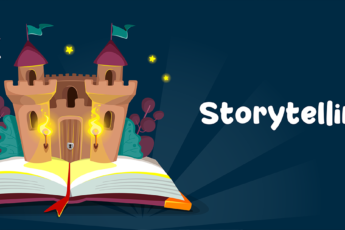Guidelines To Early Literacy Development
Early childhood education is the core of all future learning, and early literacy is its foundation.
Educators, parents, and other stakeholders in the ECCE ecosystem know that one of the most critical tasks they face is developing fundamental language skills in children. This needs to be supported in the curriculum, which itself needs to work holistically, nurturing language, early numeracy, social, emotional, and cognitive development.
Fortunately, we have the perfect guide to help you navigate this task.
Our Roadmap To Early Literacy Development
Phase I: Understanding Foundational Skills

Phonological awareness: This is the ability to recognise and work with sounds in the spoken language. For example, a child that understands sounds of a language would know that PAN was made up of three sounds from P/A/N. Phonological awareness is the foundation for learning to read and is an important component of both reading and spelling. It is the ability to recognize and work with sounds in spoken language. This skill comes naturally to some young learners, many do need help honing these skills. This can be harnessed by increasing activities like singing and rhyming, and focusing on a few sounds at a time.
Print awareness: Children also need to learn that spoken words are represented by written symbols. Print awareness translates to alphabetic understanding. As children understand how to map individual sounds to the respective letters, they gradually begin to decode words. Young children should always be encouraged to scribble their thoughts down, whether they know how to write yet or not. They can represent their ideas via pictures, or even practice certain letters repeatedly. This exposure is crucial to developing a strong grasp of print awareness skills.
Vocabulary and concept development: This stage is predictive of future academic behaviour too, and is the most critical step on the foundational literacy pathway. Constant and regular exposure to reading material in their surroundings will benefit children; they face future years of schooling armed with a larger vocabulary and well-developed language skills.
Phase II: Creating Learning Environments

Language-rich environments: A groundbreaking study by Hart and Risley (1995) showed the amount and kind of language parents use with their young children is a strong predictor of important educational outcomes. Learning centres too can adopt this language-rich environment, providing frequent verbal interaction between young learners and their educators. For instance, simple storytelling sessions can serve multiple purposes. Reading stories out loud can teach children new vocabulary and sounds, they can be given opportunities to predict what comes next, and teachers can ask questions to extend children’s verbal responses. To enhance this experience, children need to connect their own background, culture, and experiences with the learning. They need context, and the learning needs to be localised to fit these needs.
Print-rich environments: A high-quality learning environment is, by its very nature, print-rich. Children have access to an array of different literature at all times. Schools and Anganwadis can increase exposure to print by:
– creating a schedule of the day on the board and encouraging children to read and follow it
– labelling everyday objects like the desk, blackboard, and walls in multiple common languages
– creating a library of multicultural books for children to read and even take home
– investing in multilingual and multi-modal digital tools that help children develop foundational reading skills
Scheduled Reading Time: This is one of the most important components on the road to early literacy development. Daily schedules should set aside at least 15 minutes a day for reading and reading-based activities. Books—digital and physical—should be read, then re-read for better comprehension. To increase engagement, children should be encouraged to participate in lively discussions, activities, and games based on the books.
*Stay tuned for a very special reading-themed article, complete with children’s book recommendations, coming to you next week.
Phase III: Developing Adult Literacy

Responsive skilled educators and Anganwadi workers: Our guidelines would be incomplete without our teachers, educators, Anganwadi workers, and their influence on early childhood education. Responsive caregivers are key components of a literacy-rich environment, engaging children in a variety of ways and adjusting their content delivery and communication to fit their learning needs. Such educators are well-equipped to deal with 21st century classrooms and turn their students into the citizens of tomorrow.
Involved parents: Interventions at any level across the educational landscape need the support of parents. Partnerships with parents and guardians improve learning outcomes, and support in-school learning. As parents understand their role in their children’s education, early learning initiatives become stronger and much easier to conduct. At-home initiatives can then be undertaken to extend learning opportunities beyond classrooms and into homes. For instance, parents join hands with educators and Anganwadi workers to help children work on activity sheets, at-home activities, reading practice, and more.
A network of stakeholders: Quite like the African proverb, “It takes a village to raise a child,” an entire community of people must interact—and do it well—so children across grassroots in India have access to quality early education. A learning community where each stakeholder – parents, teachers, principals, administrators, Anganwadi workers, and more – can share and access relevant information at any time cultivates equal partnership between each person in this community. Eventually, an active learning community can help India build a robust and healthy early learning landscape.
Square Panda India is helping early readers and pre-readers transform into holistic learners using a multi-modal foundational literacy program backed by the latest neuroscience research. Learn more about us: ecce.squarepanda.in.
Follow us to never miss out on any updates:
Facebook — https://www.facebook.com/SquarePandaIndia/
Twitter — https://twitter.com/squarepanda_edu
LinkedIn — https://www.linkedin.com/company/square-panda-in
Instagram — https://instagram.com/squarepanda.india
PandaBlog — https://squarepanda.in/pandablog/
YouTube — https://youtube.com/channel/UCaN_P-_l30Rd0FmsGrhQLrQ




Leave a Comment